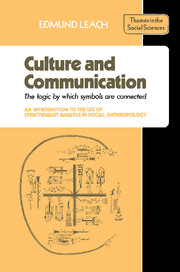 Culture and Communication
Culture and Communication Book contents
- Frontmatter
- Contents
- Culture and communication: the logic by which symbols are connected
- Introduction
- 1 Empiricists and rationalists: economic transactions and acts of communication
- 2 Problems of terminology
- 3 Objects, sense-images, concepts
- 4 Signals and indices
- 5 Transformations
- 6 Theories of magic and sorcery
- 7 The symbolic ordering of a man-made world: boundaries of social space and time
- 8 The material representation of abstract ideas: ritual condensation
- 9 Orchestral performance as a metaphor for ritual sequence
- 10 The physiological basis of sign/symbol sets
- 11 Mapping: time and space as reciprocal representations
- 12 Rank order and orientation
- 13 Examples of binary coding
- 14 Mating prescriptions and proscriptions
- 15 Logic and mytho-logic
- 16 Basic cosmology
- 17 Rites of transition (rites de passage)
- 18 The logic of sacrifice
- 19 Conclusion
- Bibliography
- Index
8 - The material representation of abstract ideas: ritual condensation
Published online by Cambridge University Press: 05 June 2012
- Frontmatter
- Contents
- Culture and communication: the logic by which symbols are connected
- Introduction
- 1 Empiricists and rationalists: economic transactions and acts of communication
- 2 Problems of terminology
- 3 Objects, sense-images, concepts
- 4 Signals and indices
- 5 Transformations
- 6 Theories of magic and sorcery
- 7 The symbolic ordering of a man-made world: boundaries of social space and time
- 8 The material representation of abstract ideas: ritual condensation
- 9 Orchestral performance as a metaphor for ritual sequence
- 10 The physiological basis of sign/symbol sets
- 11 Mapping: time and space as reciprocal representations
- 12 Rank order and orientation
- 13 Examples of binary coding
- 14 Mating prescriptions and proscriptions
- 15 Logic and mytho-logic
- 16 Basic cosmology
- 17 Rites of transition (rites de passage)
- 18 The logic of sacrifice
- 19 Conclusion
- Bibliography
- Index
Summary
It is high time that I began to persuade you that the highly abstract, formalistic, arguments that I have so far presented have some practical application when it comes to analysing the sort of ethnographic evidence with which social anthropologists regularly have to deal. In this section I shall make a start in that direction.
In Section 3 the point has already been made that while many concepts are the mental aspects of sense-images which are, in turn, a culturally determined response to objects and events in the external world, the sequence often goes the other way; that is to say we may generate abstract ideas in our heads (e.g. the opposition good/bad) and then give these abstractions manifest form by projecting them onto the external world, e.g. good/bad becomes white/black.
This is a very important part of normal thinking and calculation. By converting ideas, products of the mind (mentifacts), into material objects ‘out-there’ we give them relative permanence, and in that permanent material form we can subject them to technical operations which are beyond the capacity of the mind acting by itself. It is the difference between carrying out mathematical calculations ‘in your head’ and working things out with pencil and paper or on a calculating machine.
For anthropologists the most important area where this kind of material symbolisation is in evidence is in religious ritual. All metaphysical entities start out as inchoate concepts in the mind; if we are to think clearly about the ideas which are represented by words such as ‘god’ and ‘spirit’ we have to externalise them.
- Type
- Chapter
- Information
- Culture and CommunicationThe Logic by which Symbols Are Connected. An Introduction to the Use of Structuralist Analysis in Social Anthropology, pp. 37 - 42Publisher: Cambridge University PressPrint publication year: 1976


